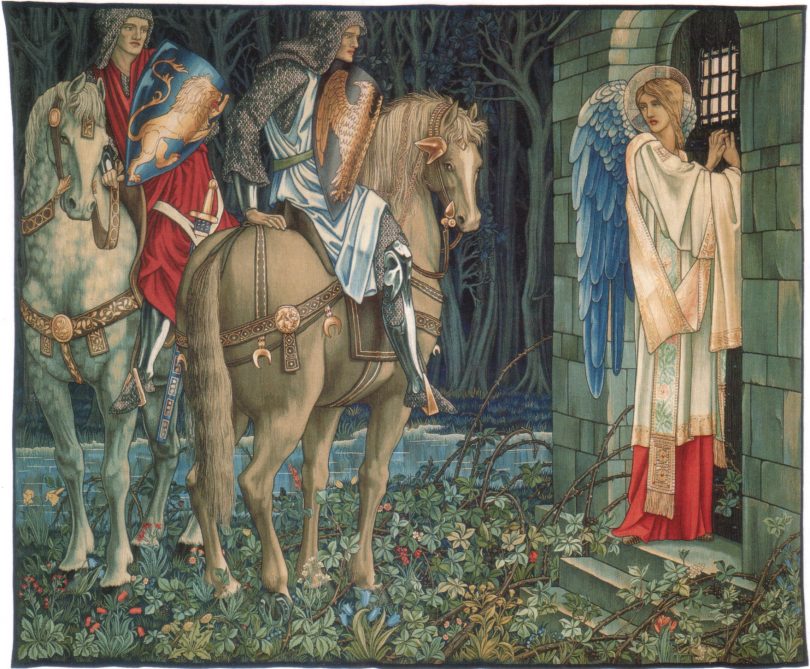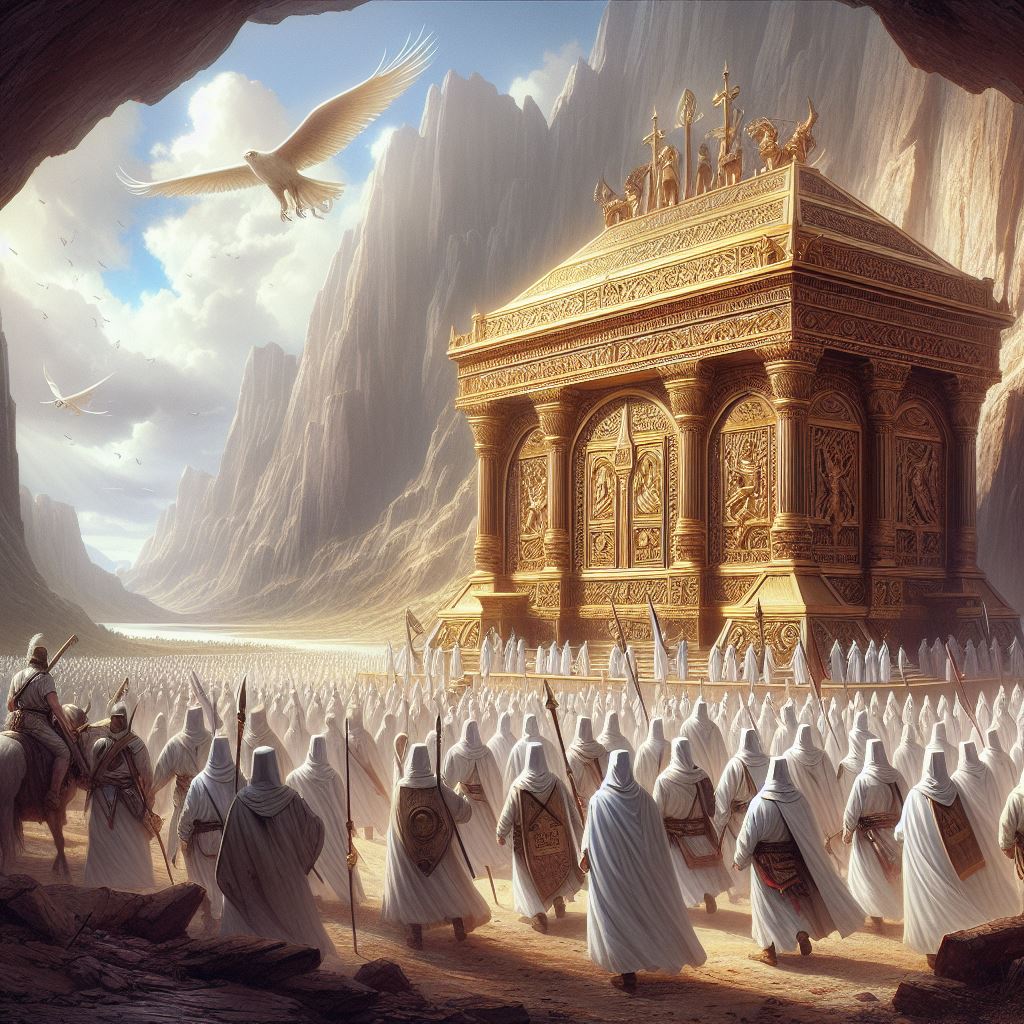
An odd tale from the medieval period…
A Yuletide feast at the court of King Arthur is interrupted by a strange figure who enters on horseback. He has a green beard, green robes and is riding a green horse. He has a holly branch in one hand and an axe in the other. The only thing that isn’t green are his eyes, which are red. But this is undeniably – the Green Knight. A threatening chap who throws down a challenge to the knights of the Round Table. One of them should strike a blow at him and in a year’s time, he will strike a blow of equal force back at his assailant.
All the knights look at him askance. So he starts to mock their fabled courage. So much for King Arthur and his glorious knights. Well, the king isn’t going to take that kind of talk lying down so he gets up to strike the Green Knight. However, just as the monarch is about to defend his honour, Sir Gawain insists that he put things right and with that Gawain chops the Green Knight’s head clean off. That should have been an end to the matter but rather unexpectedly, the Green Knight’s now headless body walks over to the head, picks it up and informs Gawain that the challenge still stands. See you in a year.
As the time draws near to meet the Green Knight, Gawain embarks on a long journey to meet him at a place called the Green Chapel where he will have to meekly receive the strike that is owed. Gawain, no doubt with an eye on his immortal soul and possibly hoping for some divine intervention this side of the grave, tries to be chivalrous and noble. But things go a bit wrong on that front when he ends up staying at a castle where Christmas is once more being celebrated – as it was a year before in Arthur’s court.
The lord of the castle is an amiable enough noble, called Bertilak de Hautdesert, who convinces Gawain to stay. The Green Chapel, he explains isn’t far away and so he shouldn’t fret about making it there on time. He then strikes a rather odd bargain with Gawain. Bertilak explains his daily routine of hunting in the forests and suggests that when he returns, the two men should share whatever gain they have made during that particular day.
Sure enough, Bertilak goes off hunting leaving Gawain to snooze in bed – where the lord’s wife pops in to get better acquainted. Gawain tries to resist her charms. But in the end he concedes a single kiss from her. When Bertilak returns, he gives Gawain some venison he has killed. Gawain responds by….giving him a kiss! On the second night, he concedes two kisses to Bertilak’s wife and when the lord returns once more from hunting and gives Gawain a wild boar he has bagged, the slightly less chivalrous knight gives him two kisses. On the third occasion when Bertilak has gone off hunting in the early morning and Gawain is left with his wife, she wants to exchange a love token. But he refuses a ring which is too valuable. However, she then offers her green girdle which has magical powers and will protect him from all harm. Well, Gawain can hardly refuse given the predicament he is about to face.
Bertilak comes back to the castle with a dead fox and gives Gawain the pelt. The knight gives him three kisses. But he does not give him the green girdle. Incidentally, you might have thought all these kisses from Gawain would have aroused some kind of suspicion in Bertilak but at this stage in the story….apparently not.
It’s the appointed time to meet the Green Knight and Gawain goes off to find the Green Chapel with the Green Girdle wrapped twice around his waist. He chances upon the mouth of a cave which he decides must be the chapel and indeed, the Green Knight appears with a freshly sharpened axe. Gawain stretches out his neck to receive what will surely be the death blow but in an act of shameful cowardice, ducks the axe. The Green Knight is rather annoyed and Gawain apologises as he bares his neck again.
The Green Knight brings the axe down a second time but then pauses, the blade just inches away, saying he was just testing Gawain’s nerve that time….what an irritating man! But we then move on to the third attempt – things always happen in three’s in medieval legends – and now he does make contact with the axe. But he only inflicts a minor wound.
Gawain grabs his shield and makes to defend himself as the bargain has now been met – in his view. The Green Knight tells him to cool it. It’s all over as far as he’s concerned too. Suddenly, the Green Knight reveals that he is Bertilak transformed in to the shape of the Green Knight by the sorceress Morgan le Fey, wicked sister of King Arthur. She had been in disguise as an old lady in Bertilak’s castle and the two of them had cooked up this (rather pointless?) scheme.
The first two blows had not succeeded because Gawain had kept his promise to exchange the gains of the day but on the third day, he had kept the Green Girdle. Only because this was to protect himself and not out of criminal intent did the Green Knight spare him. Otherwise he’d have been groping around for his head by now.
A new article in History Today points out that we wouldn’t even know about this story if it hadn’t been for the bravery of a librarian in the eighteenth century. In the year 1731, a terrible fire burnt down the Cotton Library – an incredible collection of books that over a hundred years before had been amassed by Sir Robert Cotton. This gentleman of the Tudor/Stuart period had basically hoovered up as many books and manuscripts as he could find from the old monasteries, that Henry VIII had closed down. Each of the bookshelves in this collection was topped by a Roman emperor’s bust and the indexing was linked to this so the Gawain story is referred to as ‘Cotton Nero A.X.’ It’s the only copy of the story and if it had disappeared, we wouldn’t know this tale from the Arthurian cycle.
The language used is a Middle English dialect from the north of England that reads and sounds bizarre:
The January 2012 edition of History Today speculates that the inspiring figure in this story could have been the fourteenth century prince and super-politician John of Gaunt. The Green Girdle strikes History Today as being a reference to the Order of the Garter established by Gaunt’s father, king Edward III. So, although this is notionally about Arthur and his knights lost in the mists of time, the references are firmly in the fourteenth century.
Well, that’s one theory among many and rooting around online you’ll find plenty of discussions among Gawain obsessives as to what this story is really all about.
Related articles
- The Protagonist in Sir Gawain and the Green Knight (kprudchenko.wordpress.com)
- Gawain & The Green Knight! (blackfirs3and4.wordpress.com)











